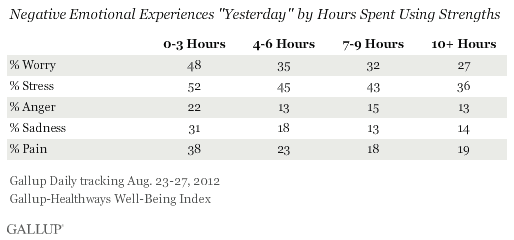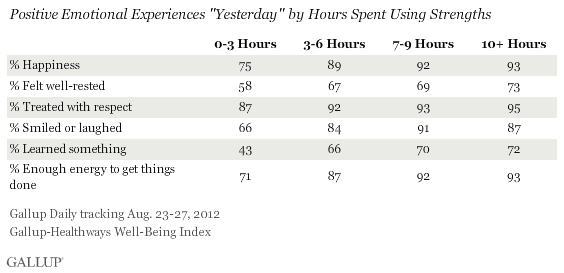WASHINGTON, D.C. -- The more hours per day Americans get to use their strengths to do what they do best, the less likely they are to report experiencing worry, stress, anger, sadness, or physical pain "yesterday." Fifty-two percent of Americans who use their strengths for zero to three hours a day are stressed, but this falls to 36% for Americans who use their strengths for 10 hours per day or more.

Twenty-one percent of Americans use their strengths for three hours or fewer per day and are, therefore, carrying a much heavier emotional burden than adults are who use their strengths throughout the day. About one in four adults use their strengths for 10 hours or more per day -- meaning that three in four adults are not using their strengths enough hours daily to achieve the maximum emotional benefit.
These findings are based on Gallup Daily tracking interviews with 5,049 American adults on Aug. 23-27, 2012. Respondents were asked, "About how many hours out of the day yesterday were you able to use your strengths to do what you do best?"
Gallup has spent more than a half-century studying human strengths and more than 7.8 million people have taken Gallup's Clifton StrengthsFinder assessment -- which tests for 34 specific, unique strengths -- since its inception in 1998.
Americans also gain a boost in positive emotions the more they use their strengths. The more hours per day adults believe they use their strengths, the more likely they are to report having ample energy, feeling well-rested, being happy, smiling or laughing a lot, learning something interesting, and being treated with respect.
Particularly important for workplaces is the added energy adults report when they get to use their strengths frequently during the day. Adults who use their strengths for 10 hours or more per day are 22 percentage points more likely to say they have enough energy to get things done than are those who use their strengths for three hours or less.

The Additive Effect of Strengths
For certain emotions -- particularly happiness and anger -- only a few hours of strengths usage are needed to maximize one's chance of having a good day. By contrast, stress and worry decrease, and respect increases with each additional hour of reported strengths usage. For each of these emotional experiences, every additional hour of strengths usage adds as much benefit as the first hour. One reason why these emotions - stress, worry, and respect -- differ from some of the others may be that laughter and anger tend to be fleeting, momentary experiences. By comparison, respect is an attitude that forms over time.
Strengths usage is often associated with feelings of accomplishment and timelessness. Energizing experiences are often evidence of strengths at work and can help inoculate adults against experiencing stress. Being engaged in an activity at a deep, natural level can result in a lack of the sense of passing time, and indicate a level of engrossment that is consistent with strengths usage. So, apparently, time not only flies when we're having fun, but also when we are using our strengths -- both act to reduce a person's chances of feeling stressed or worried about the present or future, and make life feel meaningful and productive.
Helping employees feel a more personal and meaningful connection with their work is more lucrative than many leaders realize. Gallup data show that employees who simply learn their own strengths are 7.8% more productive. Developing those strengths motivates employees to learn how to best apply themselves and makes them far more likely to care whether their activities are profitable. Being aware of and applying strengths on a daily basis is something everyone can learn to do better.
Survey Methods
Results are based on telephone interviews conducted as part of Gallup Daily tracking Aug. 23-27, 2012, with a random sample of 5,049 adults, aged 18 and older, living in all 50 U.S. states and the District of Columbia.
For results based on the total sample of national adults, one can say with 95% confidence that the maximum margin of sampling error is ±1.2 percentage points.
The margin of sampling error for any given demographic group is larger, but is typically no greater than ±4 percentage points.
Interviews are conducted with respondents on landline telephones and cellular phones, with interviews conducted in Spanish for respondents who are primarily Spanish-speaking. Each sample includes a minimum quota of 400 cell phone respondents and 600 landline respondents per 1,000 nation adults with additional minimum quotas among landline respondents by region. Landline telephone numbers are chosen at random among listed telephone numbers. Cell phones numbers are selected using random digit dial methods. Landline respondents are chosen at random within each household on the basis of which member had the most recent birthday.
Samples are weighted by gender, age, race, Hispanic ethnicity, education, region, adults in the household, and phone status (cell phone-only/landline only/both, cell phone mostly, and having an unlisted landline number). Demographic weighting targets are based on the March 2011 Current Population Survey figures for the aged 18 and older non-institutionalized population living in U.S. telephone households. All reported margins of sampling error include the computed design effects for weighting and sample design.
In addition to sampling error, question wording and practical difficulties in conducting surveys can introduce error or bias into the findings of public opinion polls.
For more details on Gallup's polling methodology, visit https://www.gallup.com/.
